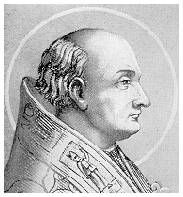|
 Bishop of Rome Bishop of Rome
Opinions remained varied as to the leadership of the church. In New Testament times, elder, presbyter, and bishop were names used interchangeably for the leaders of the local church. Deacons were appointed to help serve the needs of the church. As the church became more of an institution, the bishop emerged as a leading figure, with responsibility for an area extending beyond that of one local church. In time, the bishop of Rome came to be considered "first among equals."
Papal Prestige
Early tradition of the church seeks to demonstrate that the bishop of Rome was in direct line from Peter, claimed as the city's first bishop. The bishops of Rome claimed a role as final authority in local disputes, and the right to lead the increasingly centralized church.
With Constantine's conversion to Christianity, the bishop of Rome received new prestige. Emperor Constantine built a great basilica over the shrine of St. Peter on the Vatican Hill. He also constructed a church over St. Paul's shrine on the Ostian Way, and presented the bishop of Rome with the Lateran Palace as an official residence.
The Roman Empire was in its last days. In AD 410, Alaric, the Visigoth, sacked Rome, which had been free from effective invasion for more than 800 years. Waves of barbarians swept through Italy, until in AD 476 the last emperor in the west, Romulus Augustulus, was deposed.
Pope Leo I claimed that, as Peter's successor, the pope possessed the apostle's authority. Pope Gregory wielded his authority effectively by taking both military and civil control when Rome was threatened by the Lombards at the end of the 6th century.
 Power Struggle Power Struggle
There developed a common struggle for power between pope and emperor. A temporary truce came in AD 800, when Pope Leo III crowned Charlemagne emperor.
The new emperor began a renewal of learning, impressive enough to become known as the Carolingian Renaissance.
But peace was short-lived. In the 11th century, the popes began to take on secular, civil, and military powers, as well as the spiritual leadership of the church. The struggle between the temporal power of the kings and the spiritual pressure of the popes came to a head in the reigns of Pope Nicholas II (1059-1061) and Pope Gregory VII (1073-1085) in their opposition  to King Henry IV. King Henry was eventually driven by a revolt among German nobles to make peace with the Pope, and appeared before Gregory in January 1077. Dressed as a penitent, the King is said to have stood barefoot in the snow for three days, begging forgiveness. to King Henry IV. King Henry was eventually driven by a revolt among German nobles to make peace with the Pope, and appeared before Gregory in January 1077. Dressed as a penitent, the King is said to have stood barefoot in the snow for three days, begging forgiveness.
Dictatus Papae
These power struggles led to the clericalization of the Western Church. With Gregory, we find the creation of a Christian commonwealth under papal control. In the Dictatus Papae, Gregory claimed:
- That the Roman pontiff alone is rightly called universal.
- That he alone has the right to depose and reinstate bishops.
- That he alone may use the imperial insignia.
- That all princes shall kiss the foot of the pope alone.
- That he has the power to depose emperors.
- That he can be judged by no one.
- That no one can be regarded as Catholic who does not agree with the Roman church.
- That he has the power to absolve subjects from their oath of fealty to wicked rulers.
|
